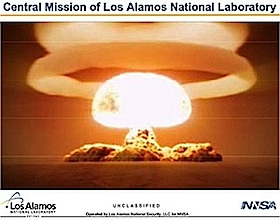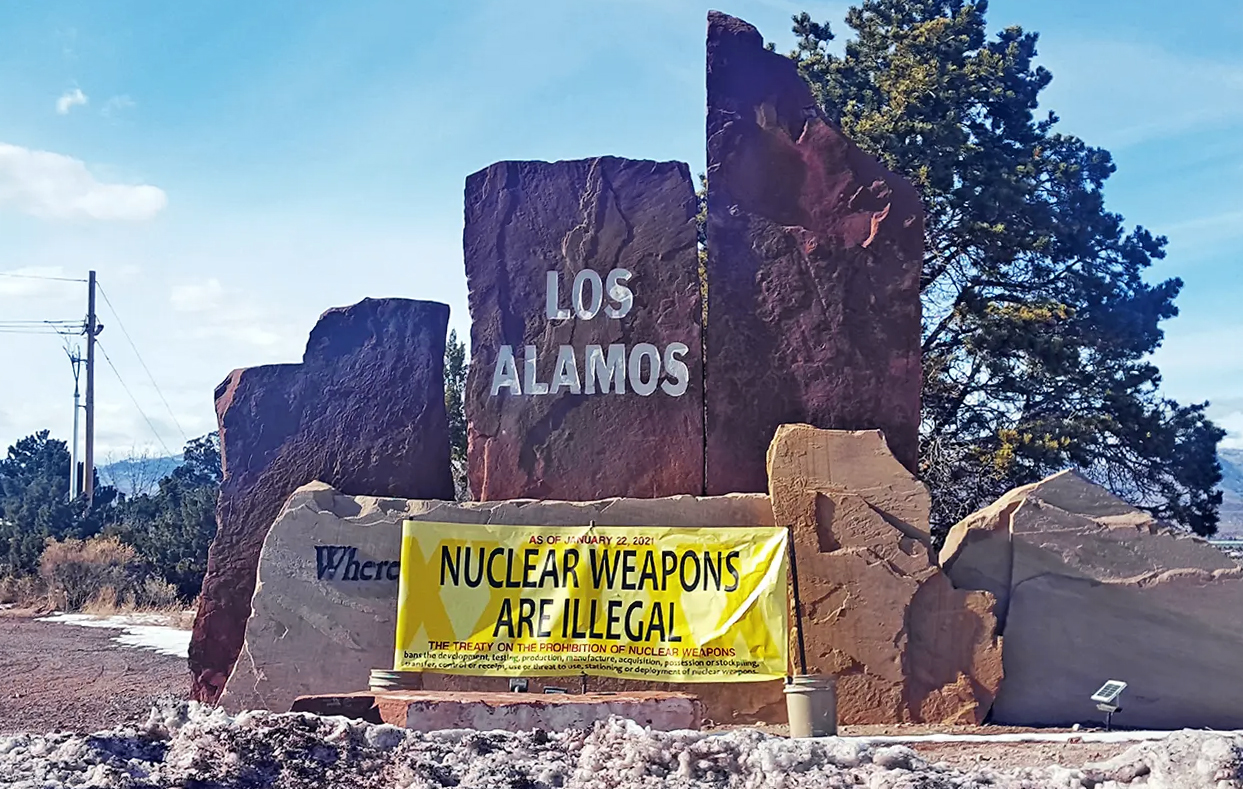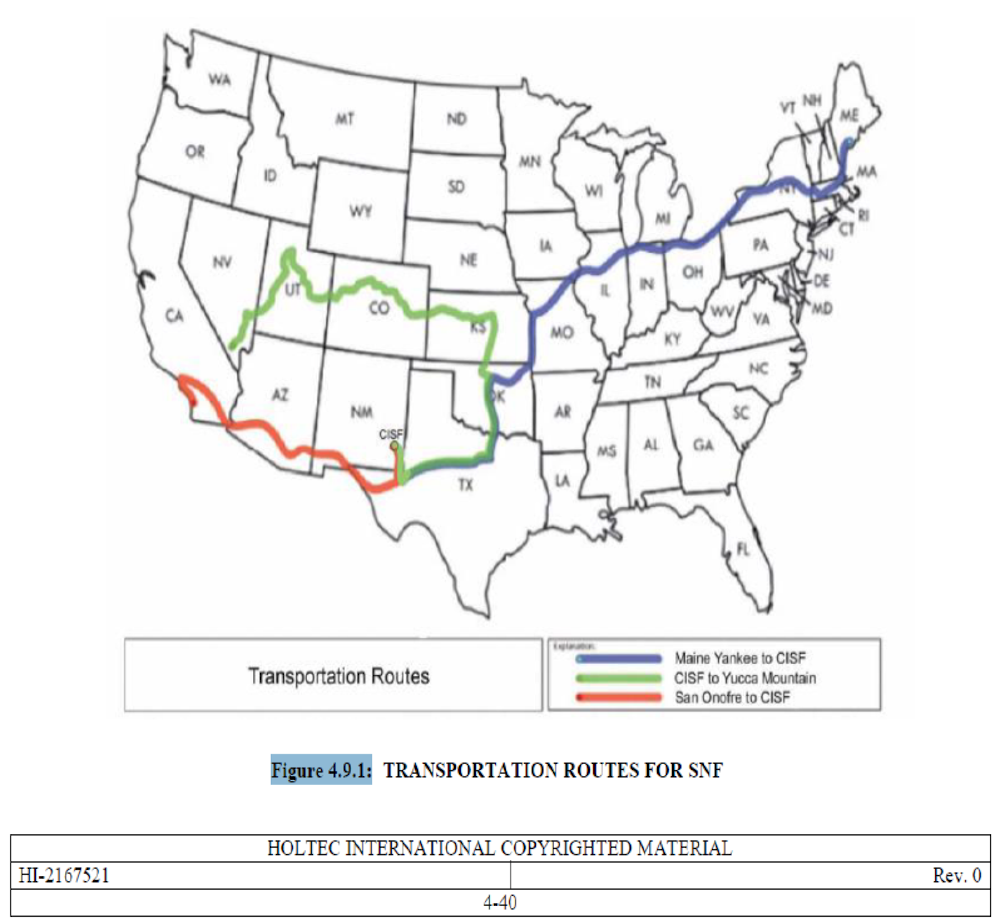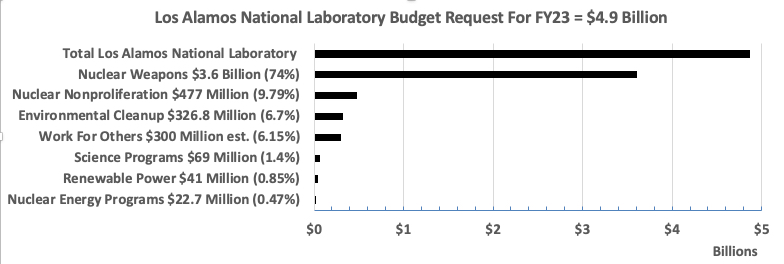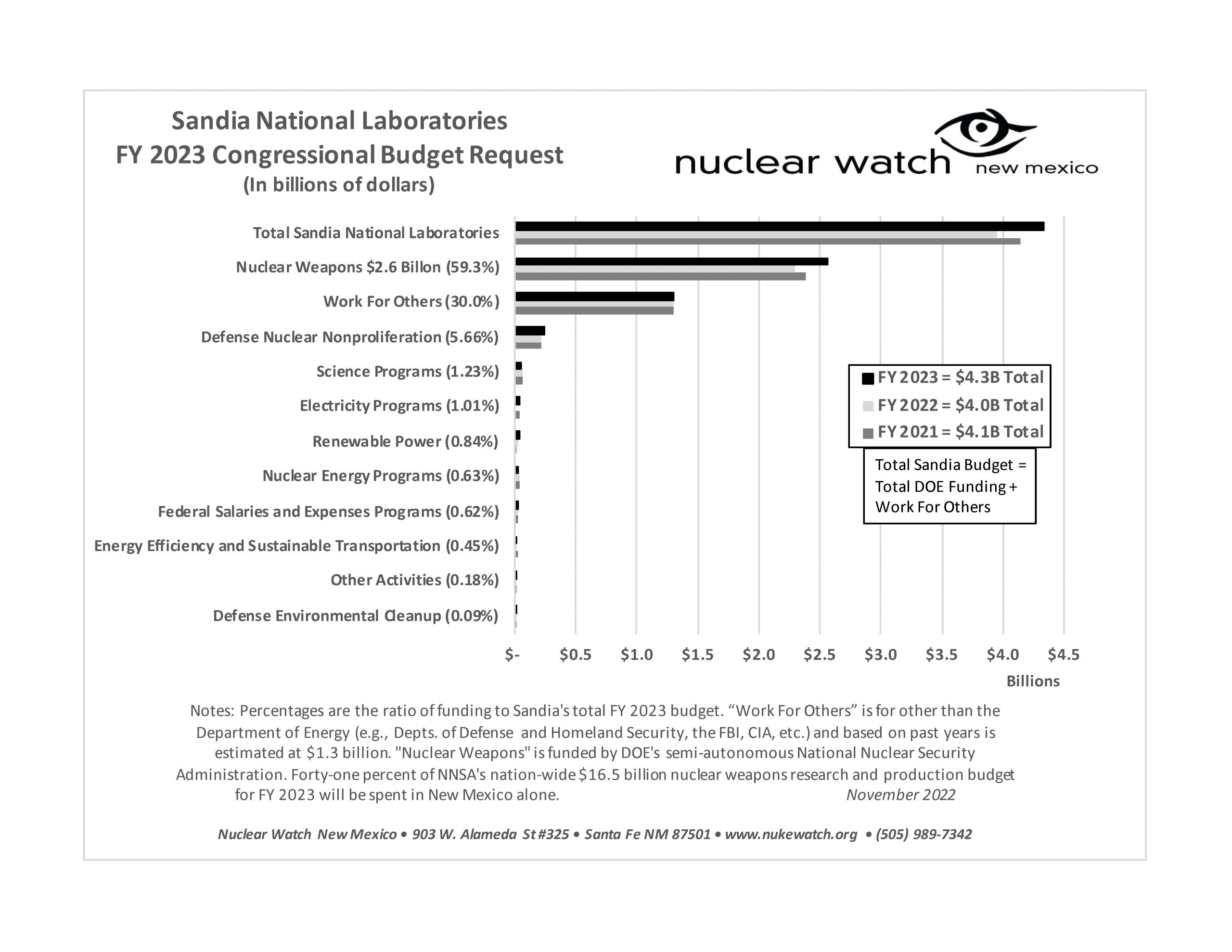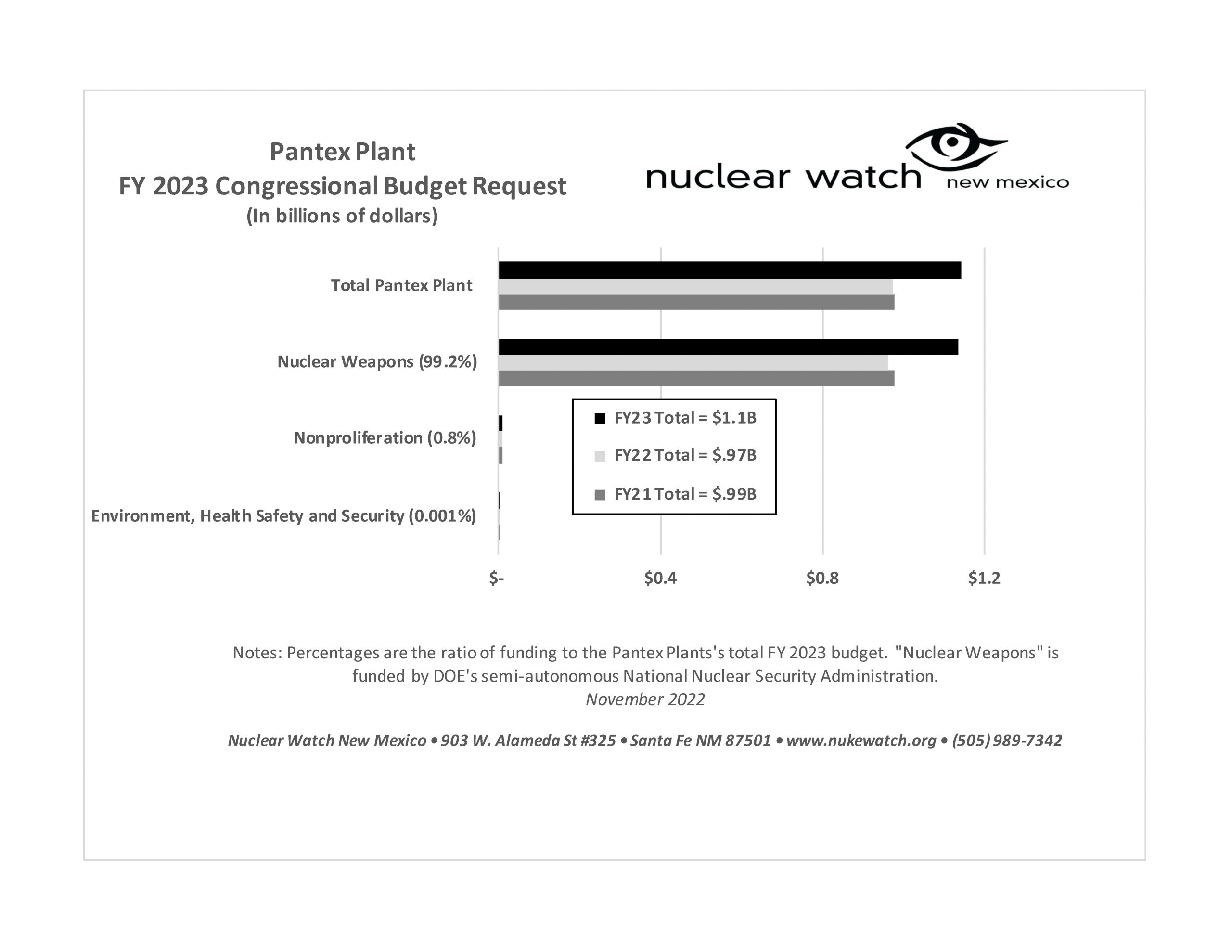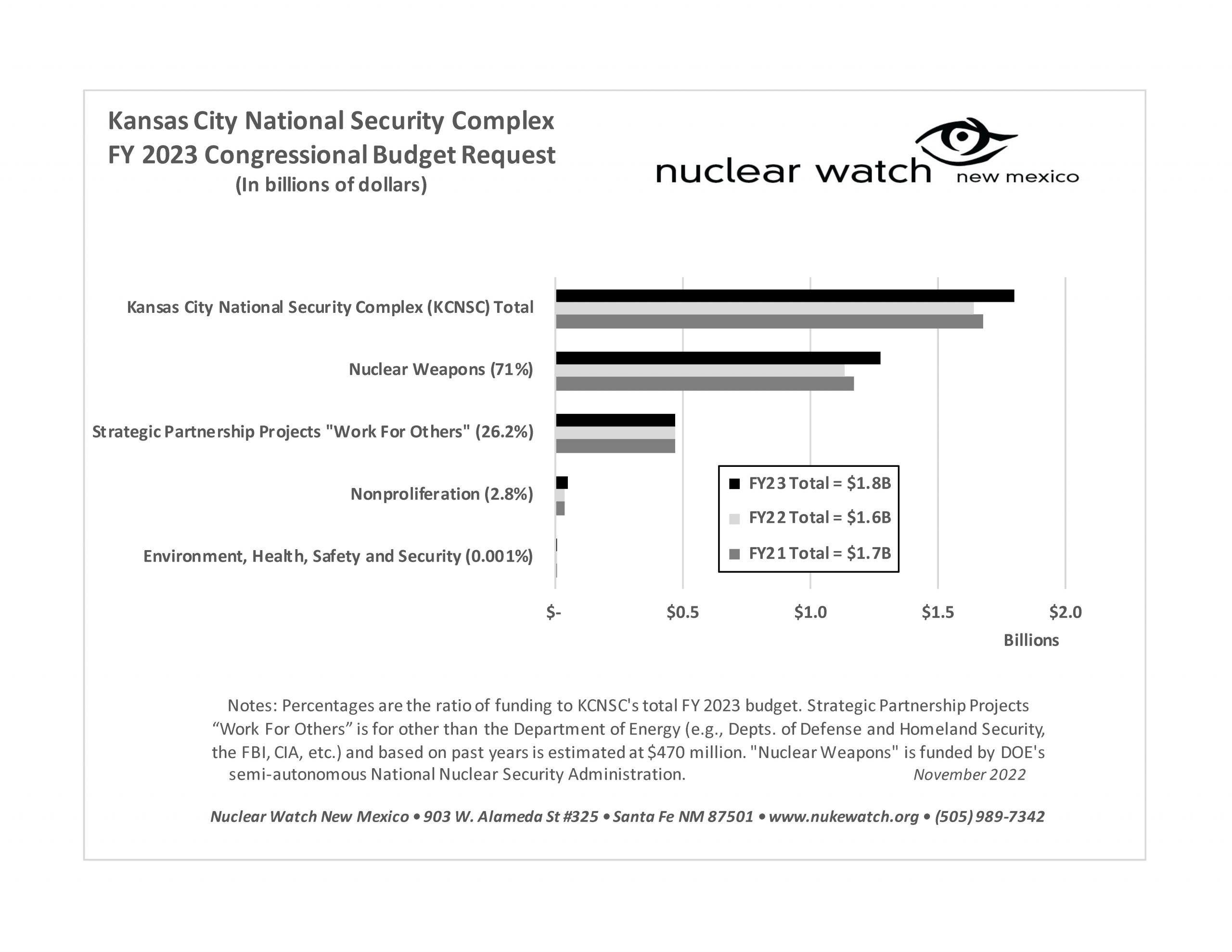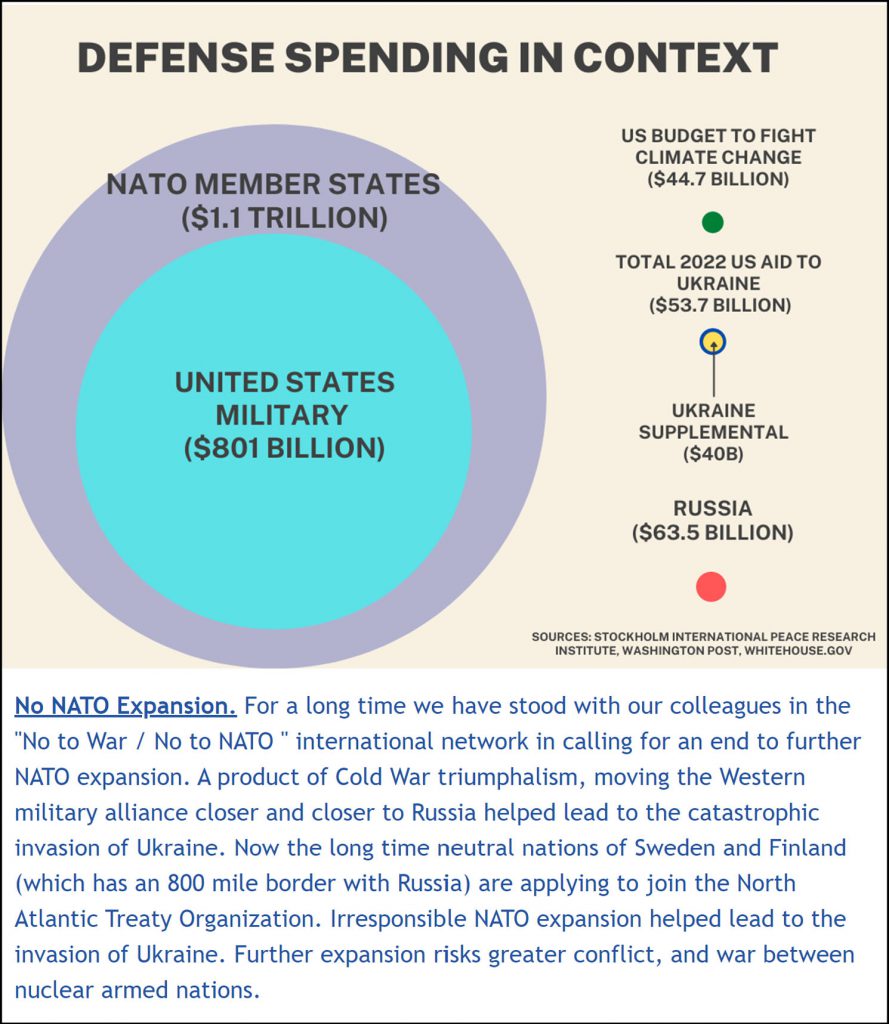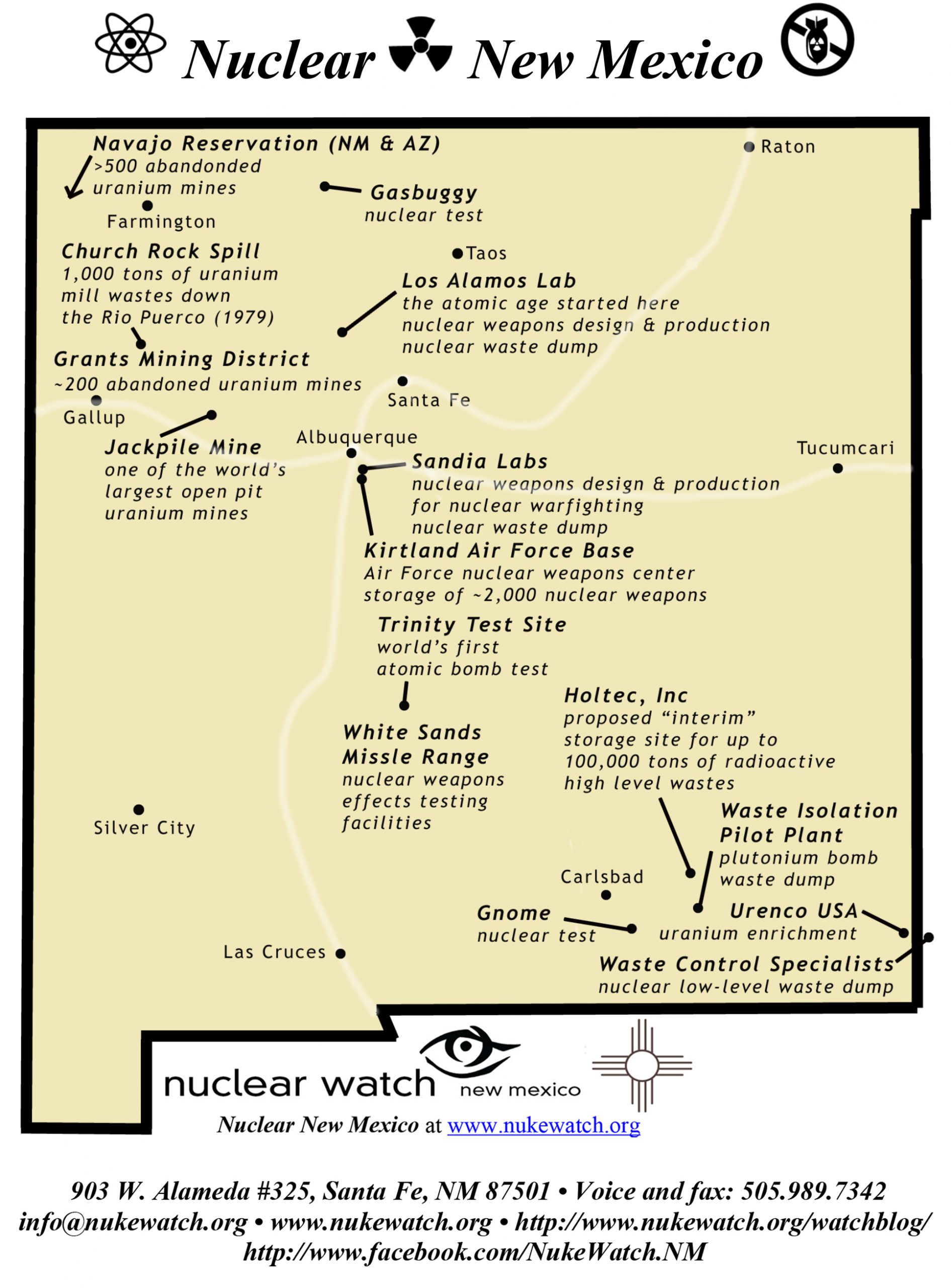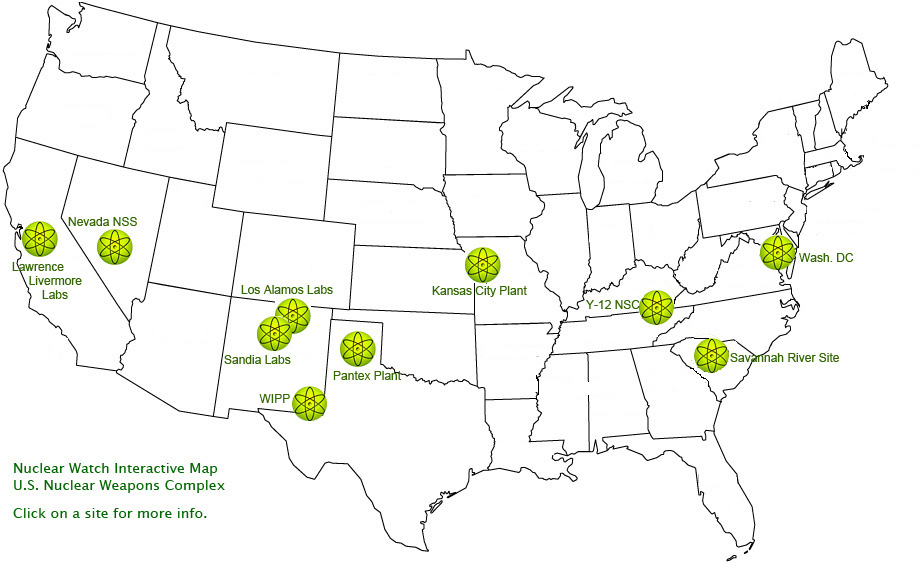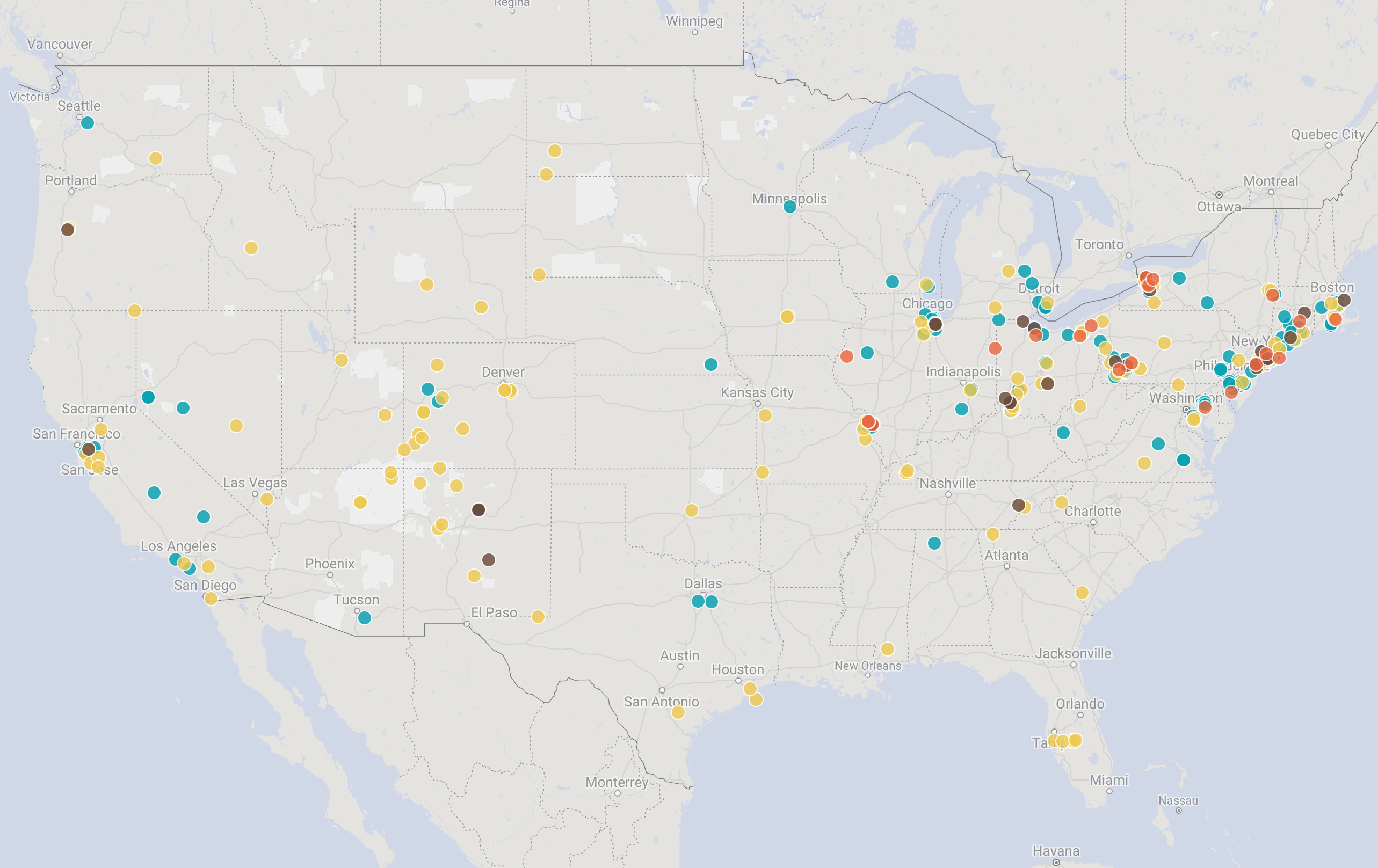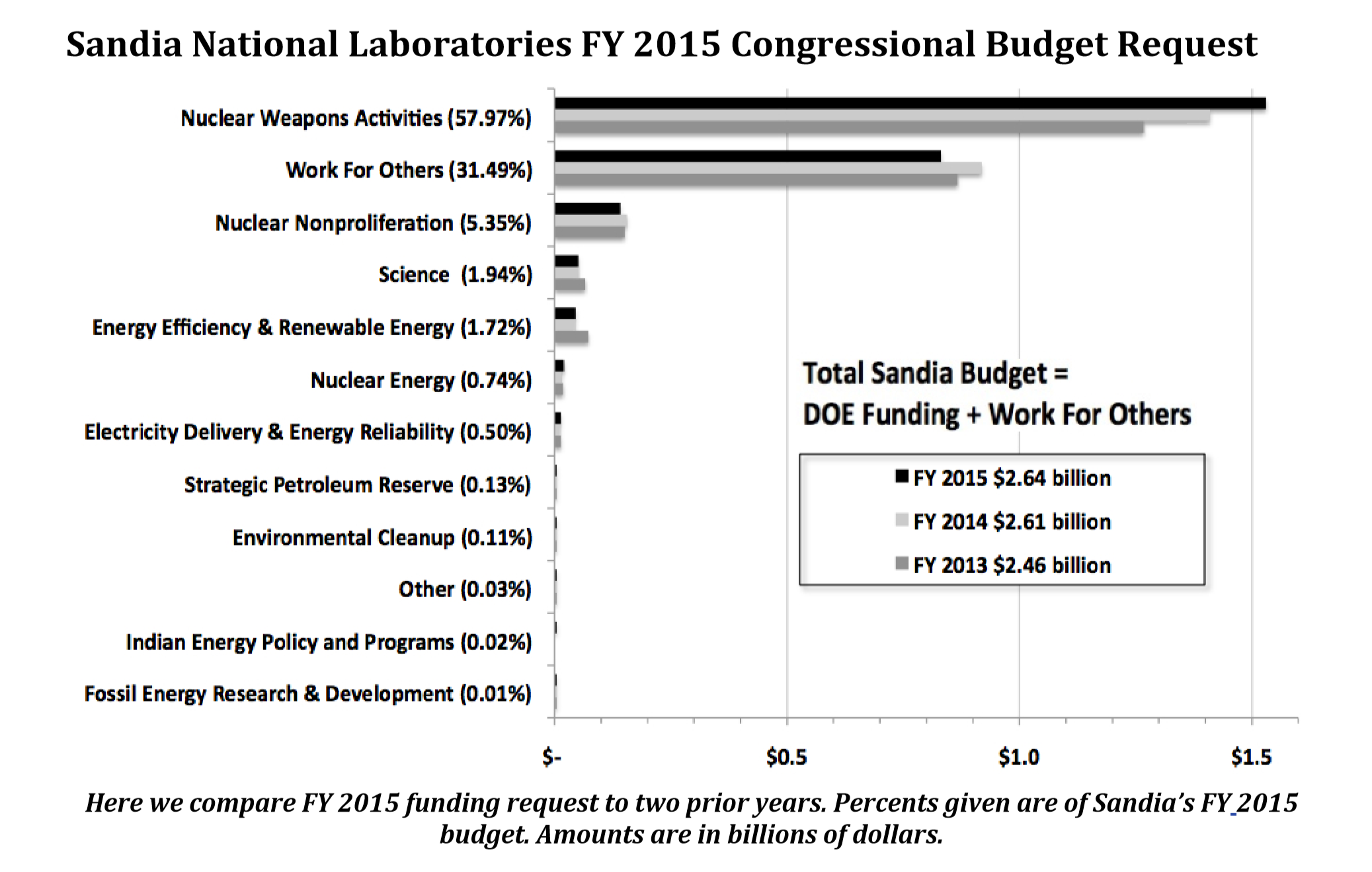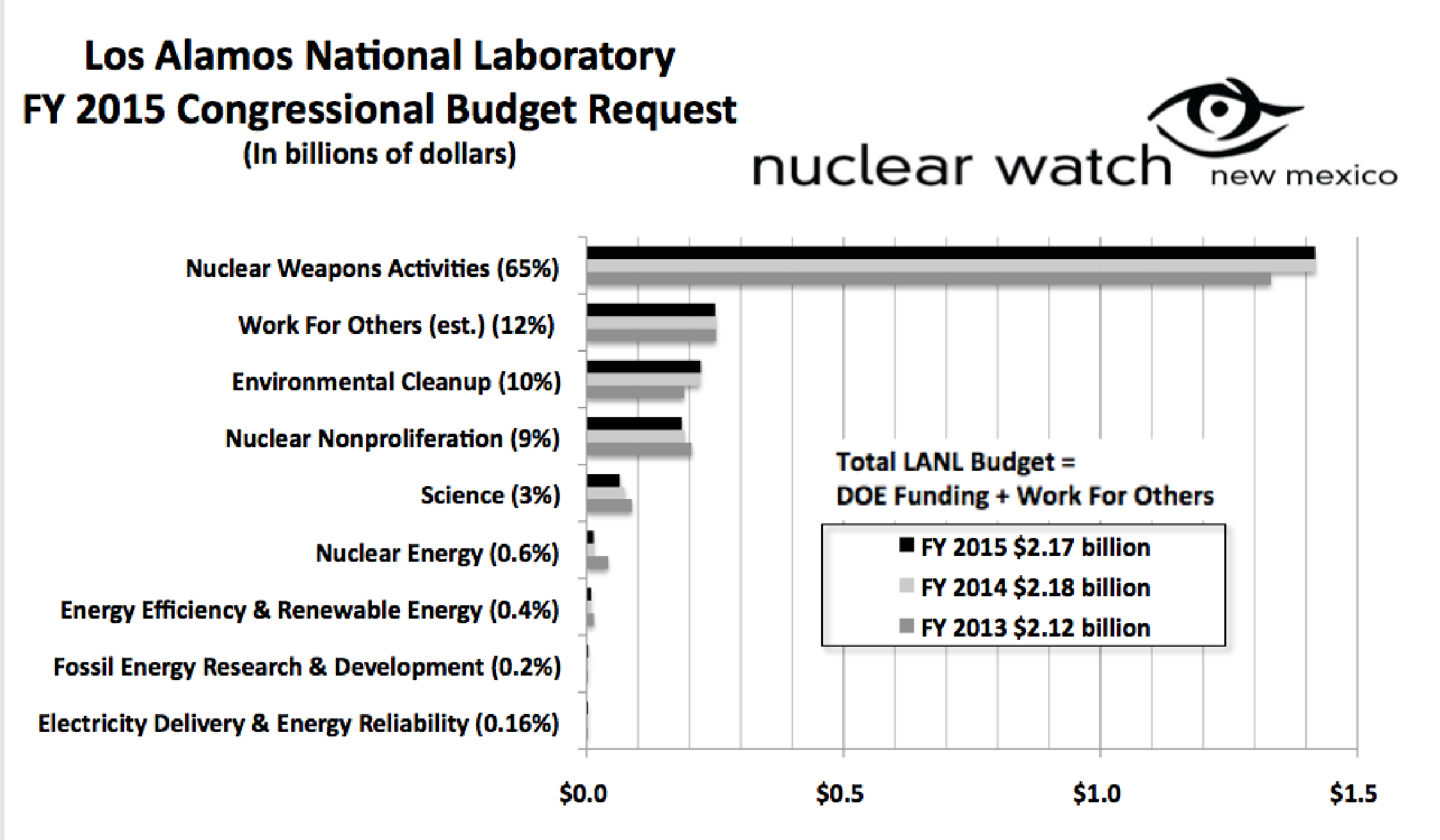QUOTE OF THE WEEK
Nothing Found
It seems we can’t find what you’re looking for. Perhaps searching can help.
LANL’s Central Mission: Los Alamos Lab officials have recently claimed that LANL has moved away from primarily nuclear weapons to “national security”, but what truly remains as the Labs central mission? Here’s the answer from one of its own documents:
LANL’s “Central Mission”- Presented at: RPI Nuclear Data 2011 Symposium for Criticality Safety and Reactor Applications (PDF) 4/27/11
Banner displaying “Nuclear Weapons Are Now Illegal” at the entrance in front of the Los Alamos National Lab to celebrate the Entry Into Force of the Nuclear Weapon Ban Treaty on January 22, 2021
Nothing Found
It seems we can’t find what you’re looking for. Perhaps searching can help.
Follow the Money!
Map of “Nuclear New Mexico”
Nuclear Watch Interactive Map – U.S. Nuclear Weapons Complex
In 1985, US President Ronald Reagan and and Russian President Mikhail Gorbachev declared that “a nuclear war cannot be won and must never be fought.”
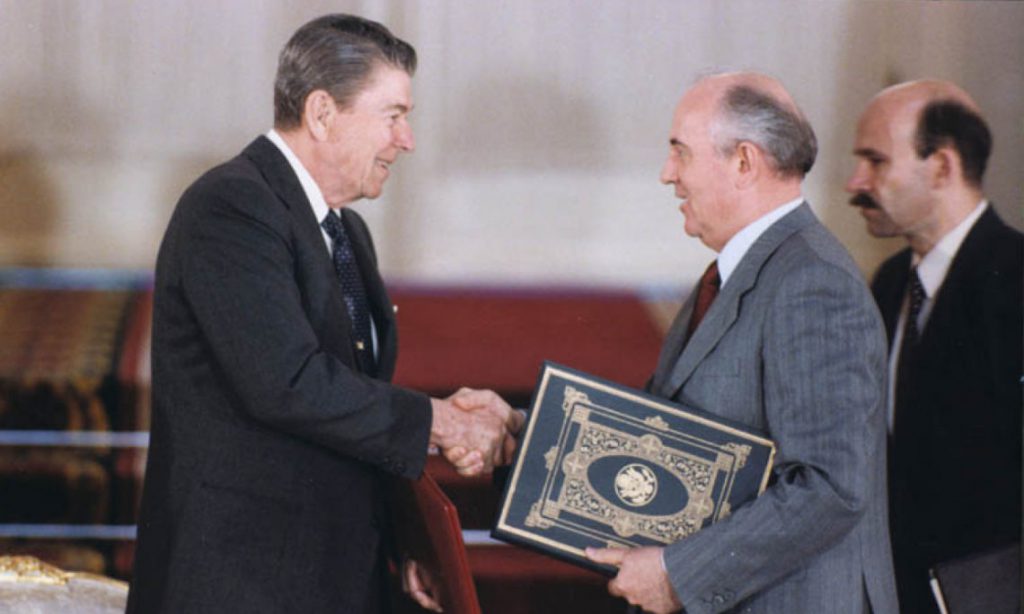
Waste Lands: America’s Forgotten Nuclear Legacy
The Wall St. Journal has compiled a searchable database of contaminated sites across the US. (view)
Related WSJ report: https://www.wsj.com
2022 BLOG POSTS
Nothing Found
It seems we can’t find what you’re looking for. Perhaps searching can help.
New & Updated
Sandia National Laboratories 101 (Sep 26, 2014)
Sandia has an estimated FY 2015 total institutional budget of $2.64 billion.
View/Download Full PDF HERE
Los Alamos National Laboratory 101 (Sep 26, 2014)
Background: The Los Alamos National Laboratory (LANL) in north central New Mexico was originally founded during World War II as the secret atomic weapons lab for the Manhattan Project. This wartime effort culminated in the “Trinity Test,” the first atomic explosive device, detonated near Alamogordo, New Mexico on July 16, 1945, which was followed by the bombs dropped on Hiroshima and Nagasaki, Japan on August 6 and 9, 1945. After the war Los Alamos developed nuclear weapons, the modern “H-bombs.” Continue reading
Scottish Independence and U.K. “Modernizing for the Second Nuclear Age”
Scots will vote on independence from the United Kingdom on Sept. 18, with polls showing the lead of anti-independence forces narrowing. If independence wins one declared goal of the Scottish National Party is to kick out the only British base for nuclear-armed strategic submarines at Faslane, effectively putting the future of U.K. nuclear forces in grave doubt. Polls show that the majority of Scots favor getting rid of Faslane.
In addition, a Review Conference of the NonProliferation Treaty (NPT) will be held at the United Nations in May 2015. Non-weapons state are growing increasingly impatient with the weapons states’ failure to abide by the NPT Article VI mandate “… to pursue negotiations in good faith on effective measures relating to cessation of the nuclear arms race at an early date and to nuclear disarmament…” In fact, the Republic of the Marshall Islands has sued the UK and others in the World Court over that failure.
NPT Article I also requires that “Each nuclear-weapon State Party to the Treaty undertakes not to transfer to any recipient whatsoever nuclear weapons or other explosive devices directly, or indirectly…” Given the interdependence of their nuclear weapons programs, the U.S. and U.K. violate this as well, as explained below.
The late Martin White, former head of Strategic Technologies for the Ministry of Defence (MOD) of the United Kingdom, made clear that the UK will not be honoring NPT Articles I and VI for the foreseeable future. The Los Alamos National Laboratory’s (LANL’s) July issue of National Security Science features an article by White entitled “Modernizing for the Second Nuclear Age.” http://www.lanl.gov/discover/publications/national-security-science/2014-july/UK-is-modernizing-for-the-second-nuclear-age.php
Some excerpts:
• You may know that we are in a period of major investment at AWE [Atomic Weapons Establishment] in terms of workforce, facilities, and programs. In the past decade, the workforce has grown from a low of 3,000to the current 4,500.
• By the end of this decade, we will have new uranium, high explosives, and assembly facilities. Just as crucial, we will have a state-of-the-art high-power laser, supercomputing, and new hydrodynamic experimental capabilities.
• In all this, our interactions with the United States have been and remain pivotal in shaping the U.K. deterrent program. And our continuing collaborations with Los Alamos National Laboratory touch the very core of our technical capability.
But the title itself contains my main point, “Modernizing for the Second Nuclear Age.” Indeed, the cover page page of the article has a dramatic picture of a U.K. strategic submarine, whose home port can only be Faslane.
This “Second Nuclear Age” is already a common theme with American nuclear weaponeers, See, for example, “The challenges facing stockpile stewardship in the Second Nuclear Age”, LANL Director Charlie McMillan, http://www.lanl.gov/discover/publications/national-security-science/2014-february/challenges-facing-stockpile-stewardship
Or “The Second Nuclear Age”, http://www.lanl.gov/discover/publications/national-security-science/2014-february/the-second-nuclear-age.php
The U.S. and UK nuclear weapons programs are very close and always have been. For example, the now head of the National Nuclear Security Administration’s (NNSA) nuclear weapons programs, NNSA Dep. Administrator for Defense Programs Don Cook, is an American from the Sandia Labs. Until a few years ago he was the manager of the UK’s Atomic Weapons Establishment as well. Also, the biggest U.S. defense contractor, Lockheed Martin, is one part of a three-part consortium running AWE.
Contrary to NPT Article I the U.S. is manufacturing neutron generators for the U.K. Neutron generators are crucial nuclear weapons components that introduce neutrons at the instant of detonation to begin the cascading chain reaction of a nuclear weapons explosion. For example, “…we noted that SNL had not established a costing methodology that consistently included a fair share of infrastructure costs to ensure full cost recovery for NG units to be built for the United Kingdom (UK). Reference: “The National Nuclear Security Administration’s Neutron Generator Activities, DOE Inspector General Audit report, page 2, http://energy.gov/ig/downloads/audit-report-oas-l-14-11
I conclude by asking questions: If they knew about it, how would the Scots feel about a “Second Nuclear Age”? Would that have any effect in their vote for independence? And how will the increasingly impatient non-weapons states feel about a “Second Nuclear Age” at the May 2015 NPT Review Conference?
Why Do DOE And LANL Refuse To Do A Pit Production Study?
Why Do DOE And LANL Refuse To Do A Pit Production Study?
A recent Congressional Research Service (CRS) Report Manufacturing Nuclear Weapon “Pits”: A Decisionmaking Approach for Congress, August 15, 2014 attempts to present the amount of space needed at Los Alamos National Laboratory for the Lab to produce 80 plutonium pits per year. CRS has to do this estimating task because the Lab has never done this calculation.
It is unclear to us why the Lab has yet to do this calculation. The Lab claims to be the “Plutonium Center of Excellence for the Nation” yet the CRS report explains that no one knows whether existing buildings, without modifications, could manufacture 80 plutonium pits per year (ppy); or if modest upgrades would suffice; or if major construction would be needed to augment the current capacity of about 10 ppy.
A plutonium pit is a nuclear weapon component that is a hollow plutonium shell that is imploded with conventional explosives to create a nuclear explosion that triggers the rest of the weapon. Some argue that the capacity to manufacture new pits may be needed to extend the service life of unneeded weapons, to replace broken pits (which never happens), and to hedge against possible unnamed geopolitical surprises where only more nukes will solve the problem. How many pits that the country actually needs to produce annually is beyond the scope of the CRS report. We believe it is zero.
Along with the unknown space requirements, the Lab also does not know how much Material At Risk (MAR a.k.a. plutonium) would be needed in the building to produce 80 ppy. “…these data have never been calculated rigorously.”
CRS created some charts for this report to show what they believe to be current usage of the Lab’s Plutonium Facility (PF-4). But what this looks like for 80 ppy is still a guess.
We at NukeWatch have been demanding that LANL produce this information — most recently in our 2011 comments on the Draft CMRR-NF Supplemental Environmental Impact Statement
We think two things a probably happening. There is still not a need for 80 pits per year (or any). And if the Lab were to finally do a pit production study, Congress would find out that LANL has enough space now.
The money should be used to clean up the Lab’s legacy Cold War waste.
Doyle Entangled in Anti-Nuclear Classification
On July 23, 2014, Los Alamos National Laboratory approved for public release an article titled Rethinking the Unthinkable, written by retired U.S. Air Force Colonel Houston T. Hawkins, with the intention of being used for public presentations.
This article argues for an increase in nuclear weapons production and expanding stockpiles. Hawkins stresses the importance nuclear weapons has for the stability of U.S. foreign policy, arguing “the march toward disarmament would take us backwards into an even more unstable and dangerous world.” This stability, therefore, is generated by nuclear stockpiles.
In addition, nuclear deterrence according to the article is an important cornerstone of national security in that it serves as “strategic parity” between states. It also yields confidence not only in the functioning of domestic stockpiles, but in the intelligence capability of U.S. decision makers in assessing foreign nuclear advancements and curtailing surprises.
DOE Sec. Moniz Calls To Speed Up WIPP Reopening While LANL Digs Up More Problems
US Department of Energy Secretary Ernest Moniz visited the Waste Isolation Pilot Plant (WIPP) recently and announced future recovery plans for WIPP and they include a target date to start some operations 18 months from now reported KRQE.
That date is extremely optimistic. Here’s a few reasons why –
- The exact cause of the February 14 release that shut WIPP down is still unknown. The cause must be determined before much else can happen.
- There are 360+ drums in Panel 6 that are suspected to have similar waste characteristics to the drum that leaked radiation. These have also now been re-characterized as “ignitable” by Los Alamos officials. Do these need to be removed and retreated? A decision is needed.
- Panel 6 must be sealed off to protect mine workers from releases.
- There are 50+ suspect drums in Panel 7 where the original release happen.
- Parts of Panel 7 must be sealed off to protect workers.
- A new exhaust shaft is in the planning stages.
- The mine should be decontaminated.
- Funding for the recovery work will be needed.
- Fines will probably have to be paid.
- If the WIPP Hazardous Waste Permit with the State is changed substantially, public comments and possible hearings will be required.
- Hopefully, a truly independent review will be approved.
In addition to these, Los Alamos officials have retroactively re-characterized many waste drums as “ignitable”. See previous post. Today it was revealed that Los Alamos has re-characterized some waste drums as “corrosive”. Ignitable (EPA waste code D001) and corrosive (EPA waste code D002) wastes are prohibited from WIPP.
The NM Environment Department, and its Secretary Ryan Flynn, has the final say about the final disposition of the now illegal waste drums and many of the other issues. We trust he will take the health of present workers and future generations into account in his decision-making. DOE’s imagined schedule should not be a consideration.
We appreciate that Los Alamos Laboratory officials have stepped up and re-characterized the drums. But we don’t think DOE officials should be making statements about the timing of WIPP’s reopening (or even that WIPP will reopen at all) until all the facts are in.
To make matters even worse, the Current Argus reported that “Moniz told the town hall meeting [that the Department of] Energy is considering the facility [WIPP] to store spent fuel from commercial nuclear power plants, but provided no time line.”
To even consider expanding WIPP when it is not even open shows the lack of focus on the current problems and shows the lessons have not been learned.
LANL Heading Down Slippery Slope With Proposed Biosafety Lab
The DOE Inspector General released Audit Report on “Management of the National Nuclear Security Administration’s Biosafety Laboratories” that calls for a re-evaluation of the proposed needs for Biolabs at nuclear weapons facilities such as Los Alamos.
The report stated that Los Alamos National Laboratory was considering a $9.5 million expansion of bio-laboratory capabilities even though the Lab could not assess current usage or future needs. Apparently the Lab based facility-planning decisions on perceptions about future demand.
From the report –
[DOE] identified the development of a BSL-3 facility at LANL as its preferred alternative for meeting biosafety laboratory needs even though it had not fully considered the need for and cost effectiveness of additional capacity. Nor, had it developed a sound basis for measuring the utilization of existing facilities – a critical factor in determining the need for additional capacity.
Biological containment levels range from BSL-1, which handles only agents not known to cause illness in humans, to BSL-4, which houses agents for which there are no known cures, such as Ebola. A BSL-3 designation permits work with virulent pathogens used in both defensive and offensive biological warfare research.
Although the BSL-3 building has been constructed, the need is very questionable. From the report –
Specifically, we contacted two of the three Federal agencies that LANL told us were prospective [Work For Other] WFO customers and officials representing those potential customers stated that they did not have any specific plans to contract for BSL-3 research at LANL. Further, officials at both agencies indicated that other existing BSL-3 facilities could satisfactorily meet their needs. In fact, one official told us that generally other existing BSL-3 laboratories were less expensive than expected at the new LANL facility and that several had comparable security.
While the BSL-3 building has been constructed, there is no compliance with the National Environmental Policy Act (NEPA). The draft Environmental Impact Statement (EIS) currently being prepared for BSL-3 facility operations pursuant to NEPA has not even been released, much less a final EIS or Record of Decision (ROD). The current schedule calls for the EIS to be released in August 2014, but if past schedule changes are indications, it is not going to happen.
The draft EIS has been in process for nine years and counting. We at NukeWatch demand that DOE start over and re-scope both the alternatives and need for the BSL-3 at LANL. LANL is working on a Biological Research Capability Assessment to assess bioscience needs, which must be completed before the BSL-3 is re-scoped.
We hope the current Assessment is more empirical than the 2011 Review, which proposed that the BSL-3 facility was essential to LANL’s mission without considering data such as available capacity at other locations and estimates of projected use from outside customers.
The LANL BSL-3 EIS was the result of a lawsuit. During 2001 and 2002 NukeWatch contested the arbitrary and capricious public process DOE was using to justify its decision to build the proposed BSL-3 facilities at LANL and Lawrence Livermore National Laboratory (LLNL). DOE failed to adequately address the many concerns raised by the public and proceeded to release final Environmental Assessments (EAs) for both laboratories, along with so-called Findings of No Significant Impact, which gives the Department the green light to begin the first steps leading to operations. Because DOE left so many legitimate questions and concerns unanswered, NukeWatch felt that a legal challenge was necessary.
In August 2003 NukeWatch and Tri-Valley CAREs, a citizens group based in Livermore, CA, jointly filed a lawsuit in the federal district court of northern California claiming that DOE had failed to fully analyze the environmental and health risks associated with the proposed operation of its BSL-3 facilities at LANL and LLNL. In effect, DOE wrote itself a blank check for a wide range of infectious disease research at the two labs. NukeWatch and Tri-Valley CAREs argued that DOE failed to consider the grave risks of introducing pathogens whose behavior may not be known or understood, and for which a cure may not exist.
In January 2004, DOE announced that it had revoked approval for its newly constructed, advanced bio-warfare agent research facility at Los Alamos. DOE went back to square one, and reviewed whether the agency needed to undertake a full Environmental Impact Statement – a key demand in the lawsuit. The BSL-3 at LLNL was built and is operating.
DOE released a notice for the LANL EIS on November 29, 2005. The Notice of Intent to prepare an EIS for the BSL-3 stated that one reason requiring preparation of an EIS was that “it was necessary to conduct additional seismic analysis of the location of the building on fill material on the sloping side of a canyon.” This calls into question not just whether BSL-3 activities can be safely conducted before these issues are resolved through the EIS, but whether any operations can be safely conducted at all.
The drawing below shows the LANL BSL-3 built in a seismic zone, on fill, and on a steep slope.

The DOE-IG report stated that LANL would need to spend about $437,000 in upgrades to attempt to mitigate this seismic concern. DOE also is spending about $478,000 to complete the now required Environmental Impact Statement
Another $595,000 is needed to open the facility, which includes $368,000 of operating costs for maintenance, utilities, etc.
Can the Laboratory be the best place for bioscience? If the Lab is looking for more funding streams, shouldn’t it be directing its attention to non-proliferation programs and cleanup?
DOE Retroactively Classifies Suspect WIPP Drums As Ignitable
DOE Retroactively Classifies Suspect WIPP Drums As Ignitable
In two letters posted to the NMED website, Los Alamos contractor and DOE Field Office officials informed NMED that 86 drums currently stored at LANL and 368 drums underground in Panel 6 at WIPP are now considered to contain ignitable wastes. These drums are part of the same waste stream as the drum in Panel 7 that is suspected to have caused the Feb. 14 radiation release and the subsequent closure of the Waste Isolation Pilot Plant (WIPP).
The letters state that DOE applied EPA Hazardous Waste Number D001 for the characteristic of ignitability.
The WIPP Permit specifically prohibits D001 Wastes at WIPP –
2.3.3.7. Ignitable, Corrosive, and Reactive Wastes
Wastes exhibiting the characteristic of ignitability, corrosivity, or reactivity (EPA Hazardous Waste Numbers of D001, D002, or D003) are not acceptable at WIPP.
DOE stated that it had “reason to believe that the nitrate salt bearing waste in the containers described above is an oxidizer and therefore the D001 code should be applied to the respective containers”, but did not explain exactly what that reason was. What did LANL or the Accident Investigation Board (AIB) discover that lead them to apply the D001 classification? The AIB report investigating the Feb. 14 release is not due until September.
Now there are 368 illegal drums buried at WIPP. DOE can’t seal up Panel 6 until the exact cause of the Feb 14 release is known, even though there is a plan to expedite closure of Panel 6. NMED Secretary Ryan Flynn has stated on several occasions that that we must know the exact cause before sealing up Panel 6. We agree. Otherwise we might be burying drums that should be retrieved and repackaged, as onerous of a task that that would be.
DOE stated, “Because the investigations are ongoing, the application of the D001 is considered provisional and may change to include and/or remove containers/waste streams in the future.” But the WIPP permit has no provision for allowance for “provisional” classification wastes.
Either they are or they are not.
LANL Fires Nonproliferation Specialist; Lab Abuses Classification Procedures to Restrict Nuclear Weapons Abolition Message
Santa Fe, NM
Today, the Center for Public Integrity broke a story on how Los Alamos National Laboratory (LANL) fired its nonproliferation specialist James Doyle. That firing followed an inquiry by the Center to senior Lab management about a study Doyle completed in his personal capacity arguing for the abolition of nuclear weapons. LANL retroactively classified his report, which Nuclear Watch believes is a clear abuse of proper classification procedures.
Doyle’s study Why Eliminate Nuclear Weapons? has long been available at our website www.nukewatch.org and an independent online publisher. Any quick reading shows it has no information whatsoever about nuclear weapons designs and materials that would merit classification. The study is instead a 28-page narrative argument by a nationally recognized nonproliferation expert for eliminating the stockpile, while citing the aspirations of both Presidents Reagan and Obama to abolish nuclear weapons. But Los Alamos Lab didn’t like Doyle’s message and sought to kill it through classification. Not coincidentally, LANL’s 2.2 billion dollar annual budget is just under two-thirds nuclear weapons research, testing, and production.
Relevant to NNSA biolabs – – C.D.C. Closes Anthrax and Flu Labs After Accidents
Today’s New York Times has a very relevant article for those concerned about biolabs at National Nuclear Security Administration sites (i.e., Los Alamos and Livermore Labs).
The money quote: “Dr. Frieden [Director of the CDC] himself suggested that the accidents had implications for labs beyond his agency, arguing that the world needs to reduce to absolute minimums the number of labs handling dangerous agents, the number of staff members involved and the number of [bio]agents circulating.”
As Marylia Kelley of Tri-Valley CAREs can attest to, Livermore is conducting aerosolized experiments with anthrax and other “select agents.” In its inadequate environmental assessment (a lesser cousin of an “environmental impact statement”) LLNL disingenuously declared a certain amount of pathogens to be at risk during a major event. We discovered only through litigation discovery that ~10 times the amount of pathogens would be permanently kept at the biolab in freezers, which NNSA did not disclose in the EA. This, of course, is near the densely populated, highly seismic Bay Area, which could have its electrical grid destroyed during a major earthquake.
See:
C.D.C. Closes Anthrax and Flu Labs After Accidents
By DONALD G. McNEIL Jr.JULY 11, 2014
Los Alamos Rated Easiest County to Live in
Los Alamos Rated Easiest County to Live in
The team at The Upshot, a NYTimes news and data-analysis venture, compiled six basic metrics to give a picture of the quality and longevity of life in each county of the nation. They were attempting to answer the question, Where are the hardest places to live in the U.S.? To create an overall ranking, they averaged each county’s relative rank in these categories: educational attainment, household income, jobless rate, disability rate, life expectancy and obesity rate.
The #1 ranking, and hence easiest place to live, went to Los Alamos County, home of Los Alamos National Laboratory, which spends 65% of its annual budget on nuclear weapons production and design. “The Lab directly employs one out of every five county residents and has a budget of $2.1 billion, which an enormous economic engine for a county of just 18,000 people,” the article states. A look at surrounding counties shows that this engine does not power the surrounding counties equally.
Rio Arriba is ranked #1966 out of 3,135 counties
Taos County = #1234
Sandoval County = #420
Santa Fe County = #148
Some specific comparisons:
63.2 percent residents have at least a bachelor’s degree in Los Alamos.
Rio Arriba County = 15.9%
Taos County = 28.8%
Sandoval County = 28.1%
Santa Fe County = 39.3%
The median household income in Los Alamos County is $106,426.
Rio Arriba County = $40,791
Taos County = $33,835
Sandoval County = $58,116
Santa Fe County = $53,642
In Rio Arriba County, 8 percent of residents are unemployed, and 1.9 percent are on disability.
The corresponding figures in Los Alamos County are 3.5 percent and 0.3 percent.
Taos County = 9.1%, and 1.2%
Sandoval County = 8%, and 1%
Santa Fe County = 5.5% are unemployed, 1% are on disability
Los Alamos County residents live on average 82.4 years
Rio Arriba County = 75 years
Taos County = 79.3 years
Sandoval County = 79.4 years
Santa Fe County = 80.1 years
And Los Alamos County’s obesity rate is 22.8 percent,
Rio Arriba County = 34%
Taos County = 29%
Sandoval County = 32%
Santa Fe County = 22%
Making nukes and the livin’s easy.
Missed WIPP Deadline May Put Real Cleanup at LANL Back On Track
Missed WIPP Deadline May Put Real Cleanup at LANL Back On Track
Santa Fe, NM – Today the New Mexico Environment Department (NMED) denied extension requests by Los Alamos National Laboratory (LANL) to delay cleanup milestones under a legally enforceable 2005 Consent Order. These denials by NMED counter a trend since January 2012 when NMED and LANL entered into a nonbinding “Framework Agreement” to ship 3706 cubic meters of above-ground transuranic waste from the Lab to the Waste Isolation Pilot Plant (WIPP) for permanent disposal. LANL radioactive wastes are now the main suspect in the February 14 contamination and subsequent shutdown of the multi-billion dollar WIPP.
NMED denied 14 extensions, now available in LANL’s Electronic Public Reading Room. These denials include construction of monitoring wells, and investigation reports for cleanup of contaminated areas. All of them included language that LANL requested an extension based on the Lab’s need to divert resources to remove transuranic waste in accordance with the Framework Agreement. The denials repeatedly state, “Based on the Permittees’ [LANL’s] statement that they will not be able to meet the deadlines that they committed to in the Framework Agreement [to ship TRU wastes to WIPP], the request is hereby denied.”
NMED had previously agreed to over 100 of these extension requests in favor of the so-called 3706 Campaign. The campaign was part of a non-binding agreement with the NM Environment Department so there are no penalties associated with lack of performance. The problem is that much other cleanup at the Lab was delayed while the 3706 Campaign was prioritized.
The Lab will miss the June 30 deadline of shipping 3,706 cubic meters of transuranic waste while the cleanup of over 1,000,000 cubic meters of all types of radioactive waste, hazardous waste, and contaminated backfill buried across the Lab were put on the back burner. These vast amounts of buried wastes, dating back to the Lab’s early days, are covered under the 2005 Consent Order for the “fence-to-fence” cleanup of legacy wastes. The Consent Order is enforceable with financial penalties for missed deliverables.
The Lab has claimed that there is not enough money to address all the Consent Order deliverables, but the original intent behind the Consent Order was that fines or the threat of fines would shake federal cleanup funding from DOE headquarters in Washington, DC. Cleanup without the big stick of possible fines just takes us back to the time when the small budget received annually just gets sprinkled around to where the cleanup “priorities” are perceived to be.
Jay Coghlan, Nuclear Watch New Mexico Executive Director, commented, “After granting more than one hundred extension requests to delay cleanup, we salute the New Mexico Environment Department for denying further requests. We encourage NMED to enforce what it already has, and make LANL comply with its legally mandated cleanup order. This in turn will drive increased federal funding for genuine cleanup at the Lab, creating hundreds of jobs while permanently protecting our precious water and environment.”
Scott Kovac, Nuclear Watch New Mexico Program Director, commented, “We look forward to continuing enforcement of the 2005 Consent Order and the necessary removal of Cold War legacy waste buried in unlined trenches above our aquifer.”
January 2012 Framework Agreement
LANL’s Electronic Public Reading Room
Missed WIPP Deadline May Put Real Cleanup at LANL Back On Track
Santa Fe, NM
Today the New Mexico Environment Department (NMED) denied extension requests by Los Alamos National Laboratory (LANL) to delay cleanup milestones under a legally enforceable 2005 Consent Order. These denials by NMED counter a trend since January 2012 when NMED and LANL entered into a nonbinding “Framework Agreement” to ship 3706 cubic meters of above-ground transuranic waste from the Lab to the Waste Isolation Pilot Plant (WIPP) for permanent disposal. LANL radioactive wastes are now the main suspect in the February 14 contamination and subsequent shutdown of the multi-billion dollar WIPP.
NMED denied 14 extensions, now available in LANL’s Electronic Public Reading Room. These denials include construction of monitoring wells and investigation reports for cleanup of contaminated areas. All of them included language that LANL requested an extension based on the Lab’s need to divert resources to remove transuranic waste in accordance with the Framework Agreement. The denials repeatedly state, “Based on the Permittees’ [LANL’s] statement that they will not be able to meet the deadlines that they committed to in the Framework Agreement [to ship TRU wastes to WIPP], the request is hereby denied.”
DOE Headquarters Launches an Investigation Into the WIPP Release
DOE Headquarters Launches an Investigation Into the WIPP Release
On June 16, 2014, the U.S. Department of Energy (DOE) DC Office of Independent Enterprise Assessments notified Nuclear Waste Partnership, LLC, the operating contractor for DOE’s Waste Isolation Pilot Plant, of its intent to conduct an investigation. The investigation will look into potential nuclear safety, worker safety, and health programmatic deficiencies associated with the two events in February.
WIPP has been shut down since February 5, 2014, when a salt-hauling truck caught fire, forcing evacuation of 86 workers from underground, 13 of whom were treated for smoke inhalation. Nine days later, an air monitor detected radiation underground where waste had recently been emplaced. The emergency filtration started, but radioactive particles were released to the environment. That resulted in contamination of all 13 people working above ground.
The DOE headquarters’ investigation may be a good start (hopefully), but Nuclear Watch NM, and many other groups, wants a truly independent, public investigation. This investigation should determine the cause of the WIPP radiation release, the extent of underground and surface contamination, the medical and compensation requirements for contaminated workers, and options for cleaning up underground and surface contamination.
In the meantime, TRU must be stored safely and securely at other DOE sites, regardless of how long WIPP is closed. Unnecessary waste shipments should not occur while WIPP is closed. Additional newly-generated TRU waste from nuclear weapons production, which exacerbates existing problems, should not be produced.
ACTION ALERTS
Nothing Found
It seems we can’t find what you’re looking for. Perhaps searching can help.
Nothing Found
It seems we can’t find what you’re looking for. Perhaps searching can help.
Interfaith Panel Discussion on Nuclear Disarmament - August 9
Nothing Found
It seems we can’t find what you’re looking for. Perhaps searching can help.
New Nuclear Media
Nothing Found
It seems we can’t find what you’re looking for. Perhaps searching can help.

